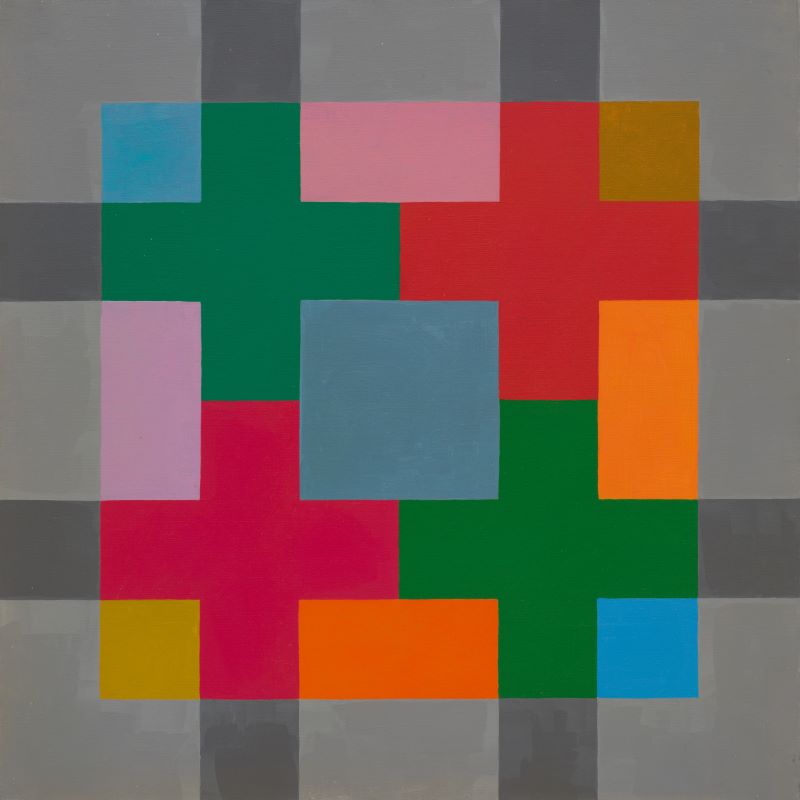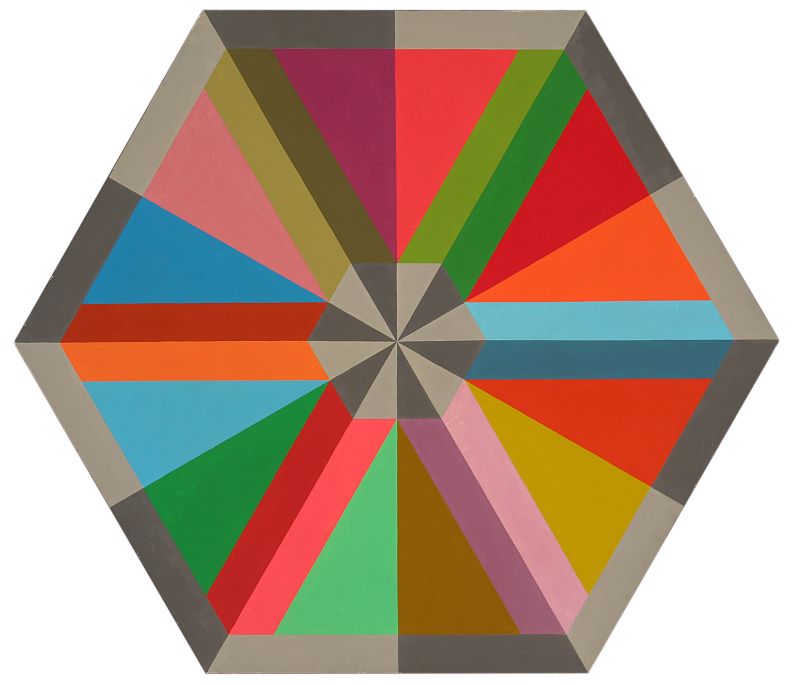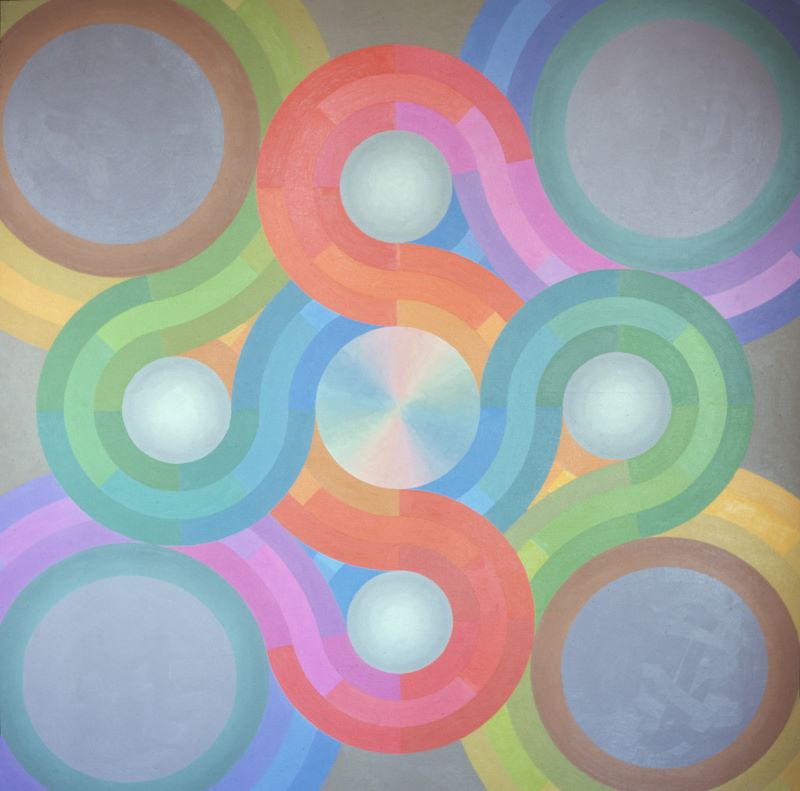
L to R: 1: George Woodman, “Piazza San Francesco di Paola,” 1966, 32 x 32 in. Oil on canvas | 2: George Woodman, “Untitled,” 1964, 49 x 49 in. Oil on canvas | 3: George Woodman, “Untitled,” c. 1965, 57 x 68 in. Acrylic on canvas | 4: George Woodman, “Untitled,” 1967, 65 x 65 in. Oil on canvas | 5: George Woodman, “Rainbow Funnel,” c. 1967-69, 63 x 39 1/2 in. Acrylic on canvas | 6: George Woodman, Notes from a lecture on Sol LeWitt, c. 1976. Woodman Family Foundation Archives. | 7: George Woodman, Notes from a lecture on Pattern and Art, c. 1979. Woodman Family Foundation Archives. | 8: Sol LeWitt, “Wall Drawing 1: Drawing Series II 18 (A & B),” 1968, each 48 x 48 in. Graphite on wall. San Francisco Museum of Modern Art © The LeWitt Estate | 9: Sol LeWitt, “Cubic-Modular Wall Structure, Black,” 1966, 43 1/2 x 43 1/2 x 9 3/8 in. Painted wood. Museum of Modern Art © The LeWitt Estate | 10: Sol LeWitt, “Serial Project, I (ABCD),” 1966, 20 in. x 13 ft. 7 in. x 13 ft. 7 in. Baked enamel on steel units over baked enamel on aluminum. Museum of Modern Art © The LeWitt Estate | 11: Frank Stella, “Harran II,” 1967, 10 x 20 ft. Polymer on fluorescent polymer paint on canvas. Solomon R. Guggenheim Museum © Estate of Frank Stella | 12: Frank Stella, “Gray Scramble,” 1968-69, 69 x 69 in. Oil on canvas. Solomon R. Guggenheim Museum © Estate of Frank Stella | 13: Alfred Jensen, In-text plate (folio 13) from “A Pythagorean Notebook,” 1965, 15 9/16 × 20 11/16 in. Composition from illustrated book with 20 lithographs, published by Tamarind Lithography Workshop. Museum of Modern Art © Estate of Alfred Jensen | 14: Alfred Jensen, “That Is It,” 1966, 42 x 36 in. Oil on canvas. Museum of Modern Art © Estate of Alfred Jensen | 15: Alfred Jensen, “The Acrobatic Rectangle Per, Eleven,” 1967, 68 x 48 1/2 in. Oil on canvas. Whitney Museum of American Art © Estate of Alfred Jensen | 16: Agnes Martin, “Orchards of Lightning,” 1966, 11 3/4 x 9 3/8 in. Ink on paper. Museum of Modern Art © Estate of Agnes Martin | 17: Agnes Martin, “Untitled,” 1963, 8 x 8 in. Brush and ink and pen and ink on paper. Whitney Museum of American Art © Estate of Agnes Martin | 18: Agnes Martin, “Untitled,” 1960, 70 x 70 in. Oil on canvas. Dia Art Foundation © Estate of Agnes Martin. All George Woodman artworks © Woodman Family Foundation. All artworks © Artists Rights Society (ARS), New York
George Woodman: A Democracy of Parts, Paintings 1966-1978 at DC Moore Gallery
535 W 22nd St, 2nd floor, New York
through May 3rd
In her essay for the exhibition’s catalogue—“The Mind as it Measures: George Woodman’s Patterns”—curator Rebecca Skafsgaard Lowery discusses Woodman’s approach to pattern and color in the context of his contemporaries. She writes:
“By the mid-1960s, pattern had become a dominant force for Woodman, often overtaking the whole of the canvas; although working in Boulder, in this he was certainly in dialogue with minimalist painters in New York such as Frank Stella, who had led the charge into post-painterly abstraction from the late 1950s, and Alfred Jensen, who began his investigations into numerically driven compositions around the same time. Ever a disciple of the aesthetic world and its place in the life of the mind, Woodman pored over works by these and other artists like Donald Judd, Jasper Johns, Sol LeWitt, Agnes Martin, and Richard Serra in the pages of art magazines and on visits to New York. These artists are constantly referenced in Woodman’s teaching and personal notes; LeWitt, in particular, was a kindred spirit in his intellectual rigor and sensitive approach to the simplest elements of square, line, cube, and color. Woodman particularly admired LeWitt’s modular sculptures, which he described as “lattice decorative element[s] taken seriously as content.”
Of this work, Woodman himself later wrote: “I saw pattern as a kind of minimalism. My paintings were intellectual and rigorous, simple, yet rich and complex.”



















